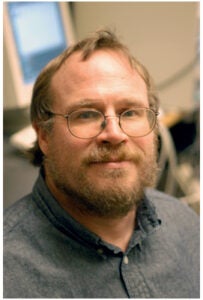
Lehmann, Kevin K.
Primary Appointment
Professor, Chemistry
Education
- BS, Chemical Physics and Mathematics, Rutgers University
- PhD, Chemical Physics, Harvard University
Contact Information
Chemistry Rm 125
Telephone: 434-243-2130
Fax: 434-243-2193
Email: kl6c@virginia.edu
Website: http://chem.virginia.edu/faculty-research/faculty/kevin-k-lehmann/
Research Disciplines
Chemistry
Research Interests
Ultrasensitive Spectroscopy
Research Description
Ultrasensitive Spectroscopy There are many problems of both fundamental and of practical importance that require measurement of extremely low concentrations of certain impurities. Molecular Spectroscopy provides one approach that excels in the high specificity provided by the detailed structure in the spectrum, particularly for molecules in the gas phase. Lehmann’s group has been working on the development of new trace sensors, largely based upon the method of cavity ring-down spectroscopy (CRDS). In CRDS, one forms a stable optical cavity using mirrors with reflectivity > 99.99% and observes absorption of a sample contained inside the cavity by an increase in the rate of decay of light that is trapped between the mirrors. Sample absorption as low as 1 part in 109 per pass of the cell can be measured in this way. The Lehmann group pioneered the use of low cost and rugged diode lasers developed for the telecom industry in CRDS and has demonstrated detection of a number of small molecules, such as H2O, NH3, and CH4 at levels below one part per billion in a sample gas. Tiger Optics, Inc. is now selling instruments based upon this work to several industries. We have developed a new, fiber optic version of CRDS and have demonstrated that this could be used to detect a single cell that sticks to the surface of an optical fiber. We are developing a new broad bandwidth version of CRDS that will allow multiple chemical species to be monitored simultaneously, such as with an FTIR, but with much higher sensitivity. This instrument uses an optical cavity formed from a pair of Brewster Angle Prism Retroreflectors that are low loss over a wide spectral range, unlike the dielectric mirrors usually used which are only low loss for a band of ~5% in wavelength. The light source is a supercontinuum, covering 500 nm – 1.8 μm which is generated using a photonic crystal nonlinear fiber. Breath analysis for medical diagnosis is an important potential application of CRDS that we would like to explore. We are presently working on detection of NO using a mid-IR CRDS instrument that uses an external quantum cascade laser as a radiation source. It is anticipated that a detection limit of ~10 parts per trillion will be realized. Rapid detection of NO can be used as a marker for infection and asthma. We are also developing an near-IR instrument to detect the 13C/12C and D/H ratios in atmospheric methane. Such a ratio is effected by kinetic isotope effects and thus give information on the chemical reactions and form and destroy methane in the environment. Spectroscopy in Superfluid Helium Research in the Lehmann group has long used laser spectroscopy and theoretical modeling to study molecular dynamics – studying chemical reactions at their most fundamental level. In recent years, this line of work has focused on the spectroscopy of atoms and molecules dissolved in nanodroplets of superfluid helium. Helium Nanodroplet Isolation (HENDI) combines many of the most attractive features of both high resolution, molecular beam spectroscopy and more traditional rare gas matrix spectroscopy. The droplets cool any solvated molecule down to a temperature of only 0.38 K but remain liquid, which allows molecules to move and rotate nearly freely with relaxation times three to four orders of magnitude longer than in traditional liquids. This allows for the study of the interaction of molecules with a unique solvent, where quantum effects dominate. Fundamental questions are yet unresolved, such as how the molecules come into equilibrium with the superfluid and why quantized vortices (which are common in build liquid helium) have not been observed in the droplets. The droplets allow the production of new chemical species and new isomers of known compounds. We are working on the spectroscopy of free radicals in helium. Traditional wisdom is that the reaction of two free radicals can occur without a barrier, but high level ab initio calculations suggest that in many such reactions (such as O2 + O -> O3), small entrance channel barriers exist and these are believed to play an important role in the rates of three body recombination; a process that produces O3 in the atmosphere. It should be possible to quench entrance channel complexes and study their properties using HENDI. We have an atomic hydrogen source and plan to use it to study reactions such as H + CO -> HCO in the helium droplets. Such hydrogen addition reactions are believed to be important in the chemistry of interstellar space. We are finishing construction of a molecular beam machine to study helium droplets doped with atomic and molecular ions. We will mass select the droplets using a hemispherical energy analyzer. We will study the translational motion of ions in nanodroplets and attempt to create vortices by driving the ions with circularly polarized microwave radiation. Among other experiments, we plan to determine the binding energies of atomic and molecular cluster ions by the measurement of the number of helium atoms evaporated from the droplet by the cluster formation.
